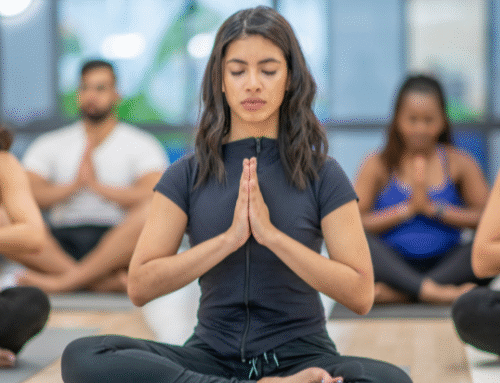What is yoga?
What is the first thing that comes to your mind when you think of yoga? Most likely you imagined a gymnast performing pretzel-like postures on a mat. You may even have thought that you can’t “do” yoga or that you aren’t “good” at yoga because you aren’t flexible enough to enjoy the practice.
What if I told you that yoga is meant to be a spiritual discipline, not merely a form of physical exercise?
It’s true! When we approach yoga as just another form of physical fitness, we are not honoring the roots of yoga. In fact, when we approach yoga as only exercise and movement, we are engaging in a form of cultural appropriation of the practice! Despite what you might have previously thought, yoga is more than postures (asana). The term yoga is a Sanskrit word which is translated as “union” or “yoked” or “to yoke”. The word yoga has several deep meanings and can be translated as BOTH a noun AND a verb. To explain:
Yoga is a spiritual practice, a discipline, and way of life. (verb)
AND
Yoga is a state of being yoked, connected, and united.⠀(noun)
The practices of yoga
The practice of yoga was first defined and outlined as an eight-limbed path in the ancient text, The Yoga Sutra of Patanjali. These practices were meant to help the student to prepare their body and mind for meditation with the intention of encountering their own true, spiritual nature.
Traditionally, the path of yoga consisted of breath-work and meditation practices. Postures later evolved as a means of enhancing the capacity of the student’s body and mind so that they could sit in meditation for longer periods of time. Yoga today is an evolving practice which is most often made up of three pillars: breath-work, embodiment or postures, and meditation. It is important to recognize the relationship here between the different meanings of the word yoga. The practices of yoga are meant to cultivate a state of yoga. This explains why yoga is meant to be more than just exercise or movement, but a spiritual discipline. Let’s explore this concept further.
Yoga as a state of being
According to The Yoga Sutra of Patanjali, the state of yoga is defined like this…
when the mind gets still, we are able to encounter our own true nature- this is the state of yoga. However, when the mind is not still, we are not able to encounter our true nature because the mind is absorbed in distractions. Yoga Sutras 1.2-1.3
As a state of being, yoga points to our ability, as humans, to gather all aspects of our being: body, mind, and spirit together in order to connect to our true nature. The practices of yoga, namely breath-work, embodiment, and meditation help the student’s mind to get still in order to gather the “fullness” of who they were created to be. When abiding in this fullness, our true nature, the student can experience yoga as a state of being yoked, connected, and united with themselves and with others. Even more, these practices can help to set distractions aside and foster a life filled with connection and communion with God, the ultimate Source. (The understanding of this “Source” can vary depending on one’s belief system and worldview. For more on this, see my course, Yoga for Christians)
Yoga as a spiritual practice
Now that we understand yoga as a state of being, let us explore yoga as a spiritual practice. How does breath-work, embodiment, and meditation practices serve the spiritual life?
Through these practices, the mind is purified allowing the student to get still and set distractions aside. This cultivates a deep state of meditation, referred to as samadhi. During samadhi, the student is deeply focused, or “absorbed” in their object of meditation. Sound woo-woo? Let’s break this down…
Have you ever been absorbed in a good book or conversation?
Did the world around you seem to fade away?
Did you lose all track of time?
This can be likened to samadhi… a very deep state of focus and meditation.
According to Patanjali, samadhi is the heart of yoga. It is the primary tool needed for achieving a life of freedom. How so? This deep state of meditation grants students freedom from every thing that would prevent them from connecting with their true nature and communing with God.
In this way, yoga as a spiritual practice can give the student new perspectives of seeing the world. When the mind is purified through the practices of yoga, the student is able to set distractions aside and focus on what is important. This enables the student to live with purpose and to cultivate a more meaningful and spiritual life.
Christianity and yoga?
So you might ask, “what does yoga offer the follower of Christ?”
Christians who practice yoga as a spiritual discipline may find that it helps them to gather the fullness of who they are created to be: body, mind, and spirit. The practice reminds us of our union with Christ and helps us to experience communion with God through the Holy Spirit.
Yoga as a spiritual practice can help Christians to purify our minds in order to live a life following Jesus. As we have discussed, the practices are meant to cultivate the state of samadhi, a pure and focused mind. Samadhi, from a Christian perspective, could be translated as setting distractions aside in order to be absorbed in Christ. Paul tells us in his letter to the Galatians that,
“It is for freedom that Christ has set us free. Stand firm, then, and do not let yourselves be burdened again by a yoke of slavery.”
When we are distracted by the things of this world, we are burdened by a yoke of slavery. If we lose our focus on Jesus, we are tempted to step out of the freedom that we have been offered in Christ and to work in our own strength. Yoga as a spiritual practice can help Christians to set distractions aside in order to set our gaze on Christ and to follow him into the world free from the power of sin and death. (John 15:14; 2 John 1:9; 1 John 2:27-28; Galatians 2:20 & Chapters 1 & 4, The Yoga Sutras of Patanjali)
Yoga gives us an eternal perspective
Yoga as a spiritual practice give us a new way of seeing. As Christians, we believe that we have been given eternal life through Christ. We are “citizens of Heaven” living in this world, but not of the world. This allows us to experience life from a different perspective.
“We are on earth for now, but our earthly lives are nothing but a vapor in comparison to eternity (James 4:14). “This world in its present form is passing away” (1 Corinthians 7:31). The sufferings and trials of this world are part of life. But, in remembering that we are “not of this world,” we know that such things are just for a little while (1 Peter 5:10). The knowledge that we are not of this world gives Christians hope even in the darkest times (1 Peter 1:6 –9). This broken place is not where we ultimately belong, and it is not where we will stay (Hebrews 13:14). “We are receiving a kingdom that cannot be shaken” (Hebrews 12:28).
Christians, as part of Jesus’ kingdom, are not of this world. We have been adopted as heirs of heaven by God Himself, and that is where our citizenship is (Titus 3:7). Until our King returns, we wait (Titus 2:13), and we hope (Romans 5:5), and we do what we can to bring others into the “not of this world” relationship with Jesus Christ. (What does it mean that Christians are not of this world?)
Yoga has many benefits to offer the follower of Christ.
Yoga as a spiritual practice can help Christians to come home to their true nature: body, mind, and spirit and remind us of our identity in Christ. The practices can purify the mind so that we can meditate on God’s word and set our gaze on Jesus. Through yoga as state of being Christians are given a heavenly perspective…We have been given eternal life. We are united with Christ. We are offered communion with God. Yoga, as both a spiritual practice and a state of being, helps us to awaken to the presence of the Holy Spirit and to cultivate a life this Spirit.
Practice Christ-Centered Yoga With Me
Interested in learning more about yoga from a Christian perspective and developing your own practice? I’d love to invite you to practice Christ-centered yoga with me inside my online yoga membership, The Yoga Abbey. We offer monthly yoga flows, meditations, and contemplative prayers. Getting Still readers can get one week free with the code 1week. Check out The Yoga Abbey today!






